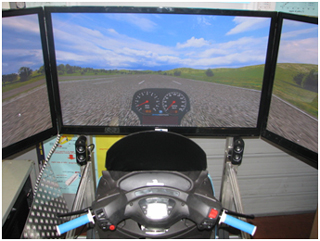
In Europe, 45 000 people die each year as a result of road accidents and more than 1 million were injured, with high social and economic costs. Italy is one of the countries most involved.
In recent years the awareness on safe driving is greatly increased, with advertising campaigns and organizing events designed to promote a proper behavior when you are behind the wheel. However, the most serious problem is that a significant number of young people die in road accidents due to inexperience, lack of capacity to react in dangerous situations, high speeds, driving during the night and traffic jam situations.
After the success of SafeBike motorcycle driving simulator, made by Motorcycle Dynamics Research Group (MDRG) of the University of Padua, it was decided to design and prototype another simulator that can be transportable. This characteristic provides more visibility of the product and gives the opportunity to join to special events (exhibitions).

The prototype has been made with the Piaggio X9 500 frame, which has been modified in order to accommodate the pins, necessary to build the roll axis.
Three TVs of large dimensions have been used to reproduce visual sensations and to display the scenario. Some speakers have been arranged, frontally and below the structure of the simulator, for the generation of the sounds.
In a second step, to improve the sensations of driving, two axial fans with adjustable tilt have been placed frontally to give the illusion of the wind and to perceive the speed in a more realistic way.
The official presentation was held during the 69th International Motorcycle Exhibition (EICMA) held in November 2011 at the Milan Trade Fair. The great success of the simulator on this event, has been a basis also for the 70th edition of EICMA held in November 2012. In this occasion the aim was to show the motorcycle behavior during low grip braking, with and without the use of the ABS. In addition the benefit of the Traction Control has been presented during accelerations on wet surfaces. The sensations felt by the riders have been positive due to the real behavior of the motorcycle simulator.

The simulator can be used for teaching young people in driving schools, or to develop and test active and passive safety systems.
It 's possible to implement different types of Traction Control in a safe environment, but with a real behavior of the motorcycle. This makes it possible to test various logics of Traction Control with riders with different driving experience (non-expert, expert, very experienced).
The simulator can also be used to implement algorithms for ABS systems, verifying the effectiveness immediately. You can also develop innovative devices (hardware-in-the-loop) aimed at driving safety.
The simulator also provides the opportunity to choose different scenarios: suburban and urban environments and race track.
